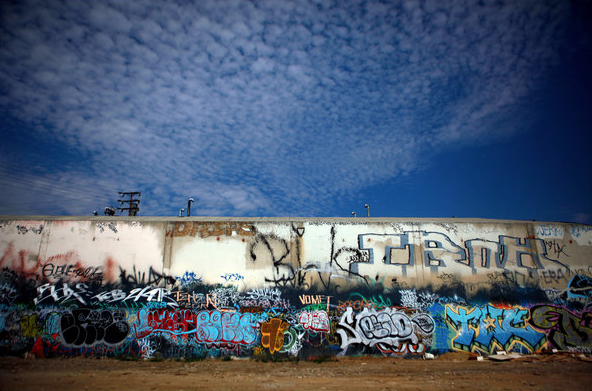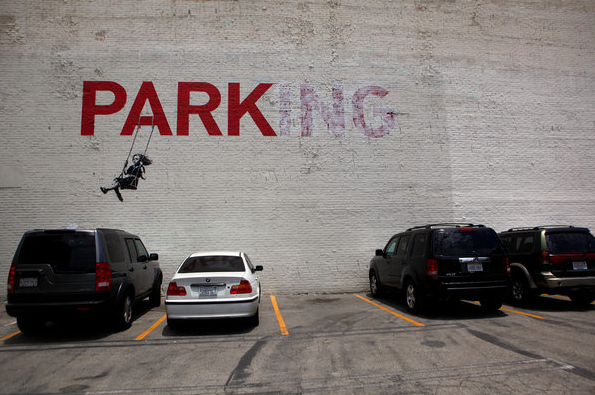I didn’t start out looking for graffiti. I had bigger fish to fry: the bad economy getting worse, and outright catastrophe looming as the GOP prepares to wreck the county rather than anger Grover Norquist. I can’t just write about national problems, however: there has to be a photograph. Whether seen as documentary record or public artwork, the image provides writer and reader alike with a basis for thinking about things held in common. But look around, from the print editions to the slide shows, and you would hardly know that the economy exists, much less that people might be out of work, underemployed, working harder for less, or otherwise worried about the future. And maybe that’s why the New York Times decided to write about an upsurge in graffiti.
Yes, it’s true: graffiti is on the rise. This image from LA captures the mood of the article: an empty, urban wasteland degraded further by anonymous vandalism, while all we should be seeing are blue skies. Now the Times can write about whatever they want, but this story is worrisome for a number of reasons. One is that it is frivolous, and the times are not. Would that the paper of record had instead zeroed in on why kids all over the country are more than usually keen on tagging property.
Another problem is that the story repeats a very tired meme that the Times has been pushing for decades, which is that graffiti always is a sign of urban decay; this despite its development as a vernacular art that can just as easily improve a community as harm it. Imagine if both porn and ballet were labeled “soft-core,” or if all risk taking from the casinos to Wall street were labeled “gambling.” In each case the label would be true, but something would be lost in translation. Graffiti can be a serious blight, but the examples in the Times own slide show indicate that there is more to the story.
My biggest gripe is with the way that the story attempts to present a balanced account. In what may appear to be sophisticated coverage, the Times reports that “The upturn has prompted concern among city officials and renewed a debate about whether glorifying such displays–be it in museum exhibits, tattoos, or television advertisements–contributes to urban blight and economic decay.” And there, in a stroke, we have it: The Times channeling Fox News. The leading explanation faults culture, not economics or politics, and suggests that a culture war is underway and the rightful center of public debate, and that the real danger comes from curators and other liberals who promote transgression in the arts and refuse to stand up to media corruption–no doubt because they are relativists rather than values voters.
Of course, in the next line the Times provides the far more plausible explanation: “But it is also stirring a debate about what is causing this recent surge and whether it might be an early indicator that anxiety and alienation are growing in some struggling urban areas in the face of stubborn unemployment and the lingering effects of the recession.” Oh, ya think? In fact, even the best uses of graffiti are likely to be on the rise for the same reason, as neighborhoods pull together around the arts when nothing more substantial is forthcoming from their leaders.
The pairing of two explanations–one where culture harms the economy, and the other where the economy affects culture–is not journalistic objectivity; no, it’s a false equivalence, and one that encourages the reader to believe that state should be treating symptoms rather than causes. The Times is schooling its readers in the same habits of delusion and denial that are at the core of the national decline. One can easily imagine the likely response: more cops, not more jobs and summer programs. More gated communities instead of more public investment. More starving of the cities by state legislatures, rather than raising taxes to nurture economic development.
And the truth gets left in the gutter. Graffiti can be a sign of decay, and cities large and small, like the suburbs and rural areas around them, are struggling with very serious problems. Most of those problems have been created by men in suits, however, not by artists in tennis shoes. Until the voters in this nation (and others) face that fact, there isn’t much one can do–except, perhaps, take a moment when no one is looking to make the best of a bad situation.
Photographs by Eric Thayer for the New York Times.
Cross-posted at BAGnewsNotes.


funny how the article missed to mention that the “park(ing)” was done by Banksy.
anyway it really reeks with strong-headed conservatism of people contempt of anyting out of order that have nothing else to do than to participate in “Beautification” and such %)
a wall with a graffiti on it is always better that a bland wall with no signs of human touch to it.
to add to what Lansur said: or worse yet, a wall covered in advertising.
“Most of those problems have been created by men in suits, however, not by artists in tennis shoes.”
Well said.
The NYT’s oversimplified graffiti story also ignores the purposeful nature of various forms. Some of it is indeed intended to mark a human presence in a barren landscape. Other forms communicate various territories and activities related to gang violence–particularly in Los Angeles. There is a huge difference in a mark to commemorate the death of a rival gang member and an effort to inscribe a human touch in a blighted area. I wish someone could assess the purpose and worth of graffitti; all graffiti is not art, but some of it is. My favorite graffitto disappeared from an abandoned building recently: “4Give Yo Self!” That message improved the urban landscape tremendously, a message of hope, vigorously inscribed in pale pink on a red brick building. Yet it received the same treatment as the repetitive and mindless tags around it, obliterated by a coat of paint.
This rebuttal of the NYT’s article is sorely needed. What also might be helpful is more photos of how graffiti can help revitalize cities. Urban decay tours are criticized but they also can be means to an end: helping showcase urban art and create jobs in communities that have been abandoned by business and political leaders. We try to help and see http://www.rustcityapparel.com, for more.
[…] STORY HERE This entry was posted in Uncategorized. Bookmark the permalink. ← SOO GOOD. […]
One irony about this whole situation is that since grafffiti is “supposedly”on the rise, more people will be needed to clean it up, therefore creating jobs and that’s something that these “men in suits” can’t (or don’t care to) figure out how to do.
I live in LA and in no way is graffiti on the rise. The whole river is whitewashed, freeways are clean. At least a lot more buffed than they were a few years back.
READ THIS http://saberone.com/blog/2011/06/20/the-devil-wears-a-pink-suit-a-response-to-radical-graffiti-chic/ then read the article… the woman’s article is a huge rant against an honest artform… she makes a complete fool of herself